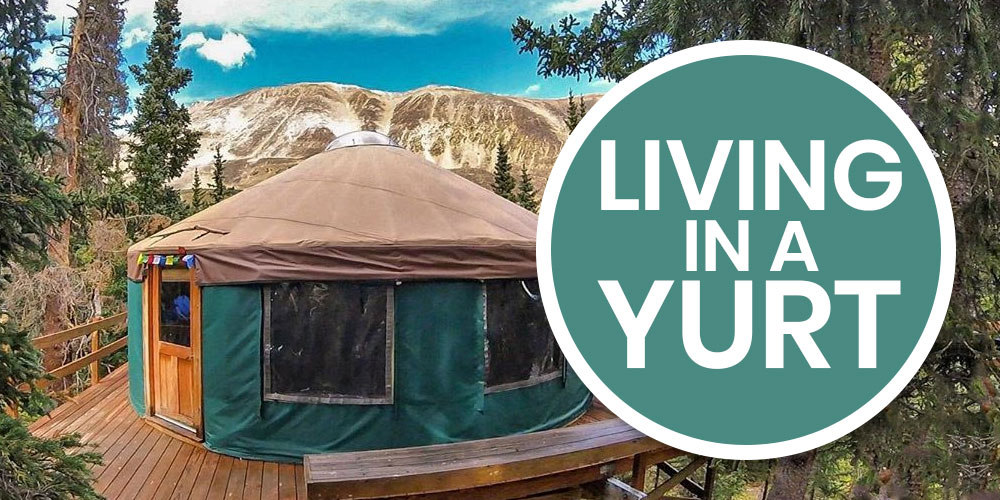
Before I moved into my tiny house, I was really interested in living in a yurt. I almost closed on some land and moved for grad school. I could have set up a yurt on the land for the same amount I would have spent on just a few months of college housing. Living in a yurt was a very affordable option.
I’ve always found the modern versions of Mongolian yurts interesting. They offer a way to set up a structure quickly on a plot of land that is more than just a tent, but isn’t a permanent as a building. They’re an excellent solution for shelter as you’re building a tiny house or setting up a homestead. Most of the time, when homesteaders buy land, they need to get on it immediately; living in a yurt presents a nice, quick option.
If you’re considering the merits of living in a yurt, here’s why living in a yurt is an excellent choice for a temporary tiny home.
NAVIGATION
What Is A Yurt?

A yurt or a “Mongolian yurt” sounds exotic and different if you haven’t heard the term. You may be wondering, what is a yurt anyway?
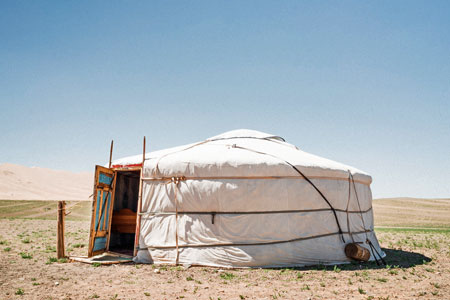 The short answer is that a yurt is essentially a round tent. These structures were native to Mongolia and were used by the nomadic groups across Mongolia and Turkey. The translation of the Turkish word “yurt” means “home,” and that’s precisely what a yurt is—a simple home.
The short answer is that a yurt is essentially a round tent. These structures were native to Mongolia and were used by the nomadic groups across Mongolia and Turkey. The translation of the Turkish word “yurt” means “home,” and that’s precisely what a yurt is—a simple home.
Traditional yurts were created out of wood, with a wool outer covering. These are portable homes that nomadic tribes would take with them as they herded sheep, goats, and yaks. The entire structure could be folded down and carried on a camel. It’s similar to the Native American tipi.
Mongolian yurts could be quite large and include different rooms, a cooking space, and more. They were often decorated with beautiful patterns, some of which aligned with Buddhist philosophy.
Today’s yurts aren’t covered in wool anymore. They’re usually made out of strong tent fabric. These yurts will withstand quite a bit of use, and there are many permanent yurt-like structures throughout the United States. Many national and state parks offer permanent yurt dwellings for campers to use when visiting. Yurts are also popular across Europe in many different camp settings.
There are several types of yurts, and when someone refers to living in a yurt, they could be discussing any of the following:
Types Of Yurts

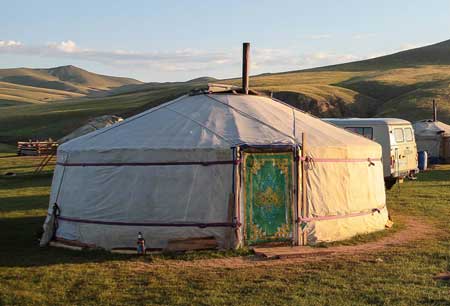
Mongolian Yurt
The original type of traditional yurt. If you find an authentic “Mongolian yurt,” it will likely be historical reconstruction (similar to a tipi).
Modern Fabric Yurt
This describes most modern yurts—a lattice structure with a fabric overlay. You can buy yurt home kits online.
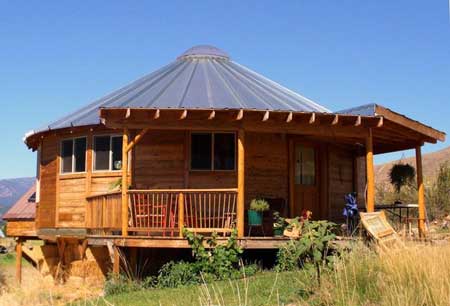
Wooden Yurts
These are made entirely out of wood and are essentially a round, home structure. There’s also the “hexayurt,” which is a hexagonal, six-sided yurt (making it a little easier to construct than a rounded yurt).
No matter the type of yurt you find is best for you, it offers a fun and affordable living option. Some hexayurt kits are available for use as indoor-friendly and backyard yurts as well. These structures are made of lightweight material and could be used as classrooms, meeting spaces, or even a studio.
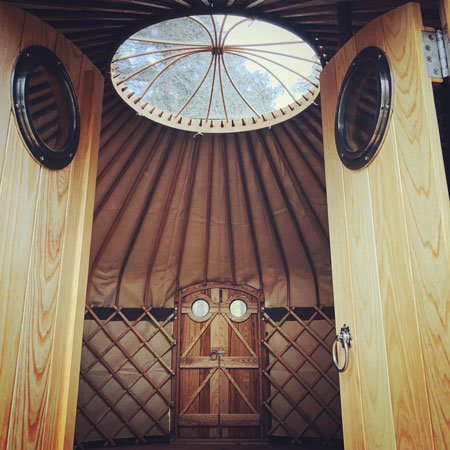 What has always drawn me to the idea of living in a yurt was the affordability. They make great temporary houses that could last years if needed. When I was looking at using a yurt home kit as a housing option, I calculated that for less than $10,000, I could set up a nice place to live. If the land cost around $5,000, a quality yurt home kit would only cost another $3,000, making it cheaper than a few months in most other housing options.
What has always drawn me to the idea of living in a yurt was the affordability. They make great temporary houses that could last years if needed. When I was looking at using a yurt home kit as a housing option, I calculated that for less than $10,000, I could set up a nice place to live. If the land cost around $5,000, a quality yurt home kit would only cost another $3,000, making it cheaper than a few months in most other housing options.
Ultimately, I didn’t end up living in a yurt, but I’ve stayed in them many times, and I find many of the traditional yurts beautiful. With a wide range of yurt home kits available, you can set up a yurt with very little assistance. It only takes two or three people to get it set up and can come together fast.
By and large, yurts are better as temporary structures. Living in a permanent yurt is an option in climates that are very temperate all year long, but a modern fabric yurt (from a yurt home kit) will degrade in 5-10 years. The fabric molds and mildews eventually.
You can think of a yurt as a step up from a tent—a “glamping” option with more space than an RV. It’s more affordable than most RVs too, but living in a yurt forever probably isn’t a realistic option. If you’re looking for a long-term home, a tiny house is a much more viable choice.
The Anatomy of A Yurt

Yurts are essentially round tent-like structures. They can be enormous, with multiple rooms and spaces just like a typical home. Yurts are circular, which can be challenging from a design and decorating perspective, but they’re also very sturdy and practical as temporary or semi-permanent yurt homes.
If you’re planning to build a yurt, it’s essential to understand the structure so you know exactly what to expect. Even if you’re living in it for a short time, you’ll want a yurt to be well-built and structurally sound.
The Base Of The Yurt

Traditional yurts were homes for nomads, who built the base of the house right on the ground. Today’s yurt owners usually set up a pre-made wooden base for their homes. Companies sell pre-made insulated bases consisting of SIPs (structurally insulated panels).
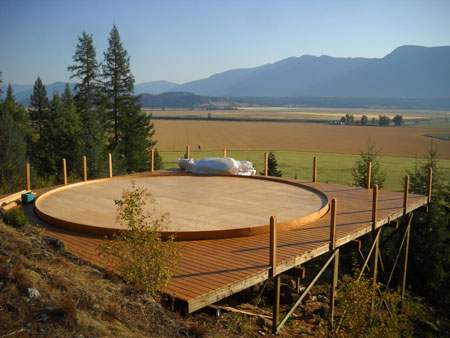 Constructing the base of a yurt is the most challenging part of building. The base must be level, which requires some intense labor. It’s also surprisingly more complex to build a circular base. Some folks opt for a big square and then build up a smaller circular base on top.
Constructing the base of a yurt is the most challenging part of building. The base must be level, which requires some intense labor. It’s also surprisingly more complex to build a circular base. Some folks opt for a big square and then build up a smaller circular base on top.
The base fabric of the yurt will need to tie into a circular base to ensure that it’s air-tight and free of bugs and pests (like a round peg in a square hole—a square base will leave gaps). Pre-made SIP yurt bases are typically the way to go. They’re insulated, and you can get the right size for what you need.
The Lattice Walls Of The Yurt

Once you’ve established a solid, insulated base, you’ll need to construct the wooden lattice walls. Some yurt builders prefer to work with bamboo, and either construction works well. It depends on where you live and what you prefer.
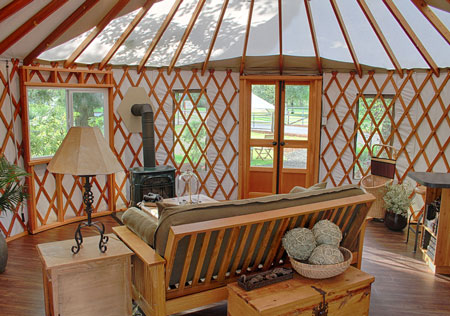 Many yurt kits include space for windows that zip closed and have a mesh screen. These are nice for ventilation and a cross-breeze in your yurt. Most yurts feature a traditional wooden front door too. You can use electric in your yurt (see my guide on setting up electric) just like a tiny house, so an air conditioner is also possible.
Many yurt kits include space for windows that zip closed and have a mesh screen. These are nice for ventilation and a cross-breeze in your yurt. Most yurts feature a traditional wooden front door too. You can use electric in your yurt (see my guide on setting up electric) just like a tiny house, so an air conditioner is also possible.
Should you buy a pre-made lattice for your yurt? Yes! While there are plans out there to show you how to build your own lattice, it’s very time-consuming (even if you’re a capable woodworker). Look at the value of your time. Even if you can do the construction yourself, you could earn quite a bit more by working with that time and buying your lattice walls from a yurt manufacturing company.
The Yurt Rafters And Ceiling

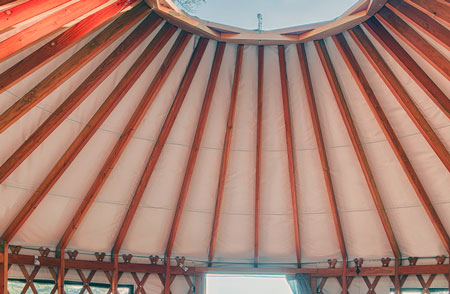 Rafters usually come along with the lattice in a wood yurt kit. Companies like Pacific Yurts sell well-made yurt home kits that help you through the building process. You could go through the build yourself, but unlike a tiny house, it’s usually much less expensive to invest in a wooden yurt kit and save yourself time and effort.
Rafters usually come along with the lattice in a wood yurt kit. Companies like Pacific Yurts sell well-made yurt home kits that help you through the building process. You could go through the build yourself, but unlike a tiny house, it’s usually much less expensive to invest in a wooden yurt kit and save yourself time and effort.
Yurt rafters come in a pair. There’s a wire that weaves between every other top part of the lattice, and then the rafters have a notch, which you place over the wire. The top usually doesn’t come together but hooks into a metal piece that forms an operable skylight (compression ring).
The Top Of The Yurt: The Compression Ring

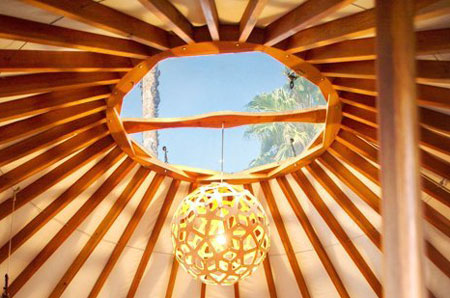 At the center of the top of the yurt, the compression ring holds the yurt together. Usually, this center ring is covered by a domed skylight. The yurt’s compression ring will also be included in most yurt home kits, and it’s an essential component.
At the center of the top of the yurt, the compression ring holds the yurt together. Usually, this center ring is covered by a domed skylight. The yurt’s compression ring will also be included in most yurt home kits, and it’s an essential component.
It would take you too long to build the bones of the yurt yourself, not to mention the engineering required and the cost of materials. Lumber is at an all-time high price and buying the lattice, rafters, and compression ring from a manufacturer is the best choice.
The Cover of the Yurt

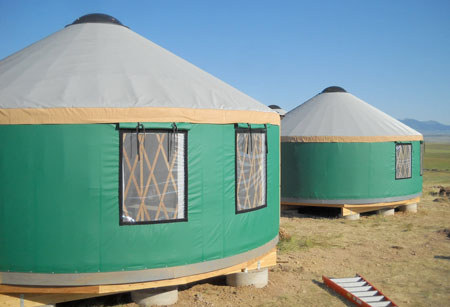 Unlike Mongolian yurts of old, most of the covers are made of waterproof vinyl or canvas backed with felt or foil insulation instead of the traditional yurt cover of wool. If you’re having any questions about buying the extra layers of insulation, you should go for it.
Unlike Mongolian yurts of old, most of the covers are made of waterproof vinyl or canvas backed with felt or foil insulation instead of the traditional yurt cover of wool. If you’re having any questions about buying the extra layers of insulation, you should go for it.
Even if you don’t live in the coldest climate, any insulation will help keep the weather out (heat and cool). The cover has some insulation similar to bubble wrap with foil on either side. Most of the time, it’s rated at an R3 or 5, which is about 20% of the code. It’s well worth the price to increase your comfort with extra insulation.

Building A Yurt Platform and Setting Up A Kit

If you’re ready to try living in a yurt, the first step will likely be to select a yurt kit and decide where you’d like to set up your yurt on your property. Look for a flat area of land that’s large enough to accommodate a yurt. There is a range of sizes, up to a 50-foot yurt and beyond. So like a tiny house, select the size that meets your needs (especially if it’s a long-term temporary dwelling).
You can build the platform yourself. It’s very similar to building a deck like you’d set up on the side of a house. Eventually, you could even use this platform as a spot to set up a deck area for your tiny house. If you’d like a semi-permanent structure, it’s worth it to hire a deck company. Most will come to any field and build you one.
Setting Up A Yurt Kit

The easy thing about a yurt home kit is that it usually comes with detailed steps and instructions. Keep in mind that you probably won’t be able to set up a yurt fully by yourself. It will take around 2-3 days once the base is built and requires several people. It’s more involved than setting up even an elaborate tent.
If you go the DIY route, there are many DIY yurt guides online to help. My advice would be to consider the time and effort you’re going to put into a temporary home. Building a yurt from a kit isn’t terribly expensive and is a much better investment of your time and money.
Even with a kit, you will need to plan out several days and several helping hands. However, you won’t need a whole bunch of tools outside of a drill, screwdrivers, a level, post-hole digger, shovel, and string. Remember that nomadic farmers who built Mongolian yurts needed to set up a dwelling without much effort or many tools.
The Basic Steps Of Setting Up A Yurt Home Kit

Here’s a great example of setting up a yurt kit (with an elaborate interior design).
The Challenges Of Living In A Yurt

Whether you build a yurt yourself or buy a yurt kit, there are advantages and disadvantages to living in a yurt. Here are a few challenges of yurt living to consider before you commit.
Code Enforcement

 I recommend always having the installation manual from your yurt home kit handy to help you navigate code enforcement. If local building code enforcement should question the structure, you’ll be able to show them how you plan to affix the yurt to your platform or how it will perform in high winds or storms. The manual is a great backup. Choose your words carefully; rather than saying, “I want to live in this,” explain that it’s a temporary house.
I recommend always having the installation manual from your yurt home kit handy to help you navigate code enforcement. If local building code enforcement should question the structure, you’ll be able to show them how you plan to affix the yurt to your platform or how it will perform in high winds or storms. The manual is a great backup. Choose your words carefully; rather than saying, “I want to live in this,” explain that it’s a temporary house.
Buying a kit will allow you to check everything out before you build. If your code enforcement isn’t okay with the yurt structure, you’ll know before you’ve spent hundreds of hours constructing a platform, creating a lattice, and setting up your yurt. Learn more about yurt building codes here.
Yurt Insulation

Another challenge of living in a yurt is insulation. You’ll only be able to get up to an insulation rating of 5, which is basically the same as a sturdy tent. If you live in a climate with a lot of rain or humidity, you’re going to battle dampness and moisture continuously. So living in a yurt in a rainy climate like the pacific northwest could be a challenge.
If you live in a very cold climate, the insulation will not offer much protection from the weather, either. The insulation isn’t nearly as strong as a house, and even with a heater, it will get very cold. Similarly, hot weather can be a challenge too. Although, if you go ahead and wire the yurt for electricity, a fan or small air conditioner can keep you pretty cool. Yurts are well-ventilated, so warmer climates are your best option.
Security

Yurts aren’t secure. Period. It’s a piece of fabric on a wood lattice, so it’s not an extremely sound structure against outside forces. A hexayurt made of wood may offer some additional security, but not much.
If you live in an area where hurricanes or tornados are prevalent, then a yurt is probably not a safe or practical option. While it’s safer than a tent and will keep out some basic natural forces, it’s not going to be as secure as a house.
Kits Are Heavy

The wood yurt kits are very heavy and impossible to move on your own. It’s not wise to attempt to build a yurt by yourself (even from a kit). When you order the yurt kit, you’ll need to plan on appropriate delivery transportation. You may receive the kit via freight, but you may need to rent a lift gate or mini forklift to move the kit.
If you’re a homesteader, a tractor may also be an option for moving the yurt kit. Sometimes land can be inaccessible to delivery drivers, too, so it’s essential to have a plan of how you’ll get your kit to your foundation.
Fabric Doesn’t Last Forever

Yurt fabrics have a shelf-life of about 5-10 years. At that point, you’ll need to invest in a new cover. While the shells are affordable, they’ll degrade over time, and you’ll need to replace them and perform upkeep and repairs.
If you build your yurt carefully, with a strong structure, then it can last a very long time. But keep in mind, you’ll probably need to continue to replace the fabric roof, walls, and possibly the insulation layer regularly.
Curved Walls Present A Challenge

From a decorating and design perspective, the yurt’s curved walls are tricky. You can’t put a couch against a curved wall. You can’t hang things from latticework or the fabric. You also shouldn’t have anything flush against the wall because it’s a tent—you’ll want ventilation for drying should the walls get wet.
The workaround with a yurt is to either opt for a hexayurt with wooden, flat walls (basically a hexagonal tiny house) or to build a nice, sturdy interior structure with walls as partitions. I’ve seen some elaborate layouts, and I’ve listed several ideas for yurt layouts here.
How Much Is A Yurt Kit?

Assuming you go with a yurt home kit to build your yurt, you’ll look at a kit price range between $4,000 and $13,000. It will depend on the size of your kit, the materials, and what’s included with the kit.
Yurt kits generally range from about 12-foot yurts to 30-foot yurts. Some larger kits will even build a 50-foot yurt, so there’s quite a large selection. Keep in mind that the price of the kit is usually just for the lattice, roof, tension ring, and outer fabric. The extras for your yurt will usually cost more.
Most kits don’t include the base or foundation, so you’ll need to figure in the price of building a deck and platform. They won’t have heating or HVAC, water, a power hookup, or any amenities for building out and furnishing the inside.
Still, for around $10,000 (especially if you already own the land), a yurt offers an ideal temporary home for months or even years as you work on building a tiny house or setting up a homestead.
Yurt Layout Design Ideas

I’ve created some layout design ideas to help you brainstorm the ways to set up your yurt. Because the structures are pretty versatile, you can set up space for one or two people to simply sleep or an extensive more permanent yurt home.
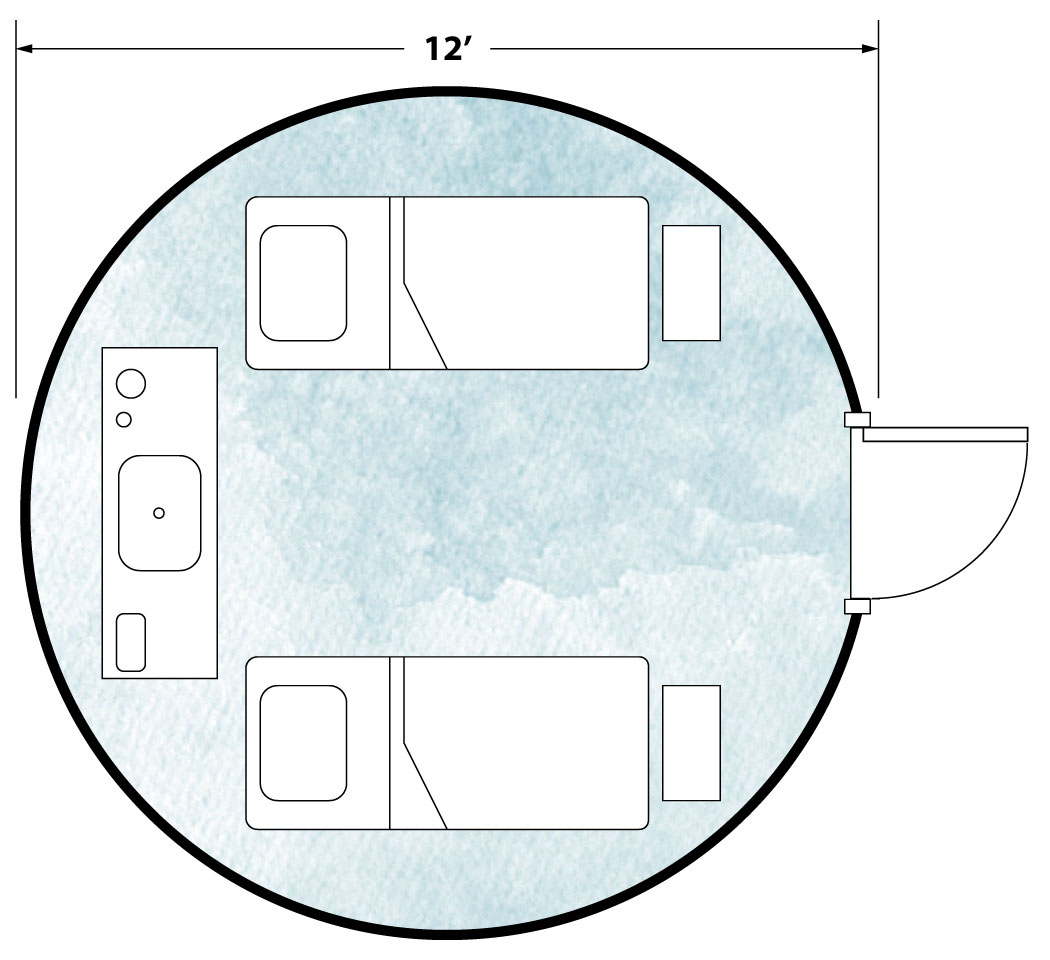
12-Foot Yurt Layout
A 12-foot yurt home is a cozy but comfortable room for a single person or could be set up for two people as a temporary weekend camp. A small yurt will make a lovely guest dwelling if you’re looking for a way to host people at your tiny house.
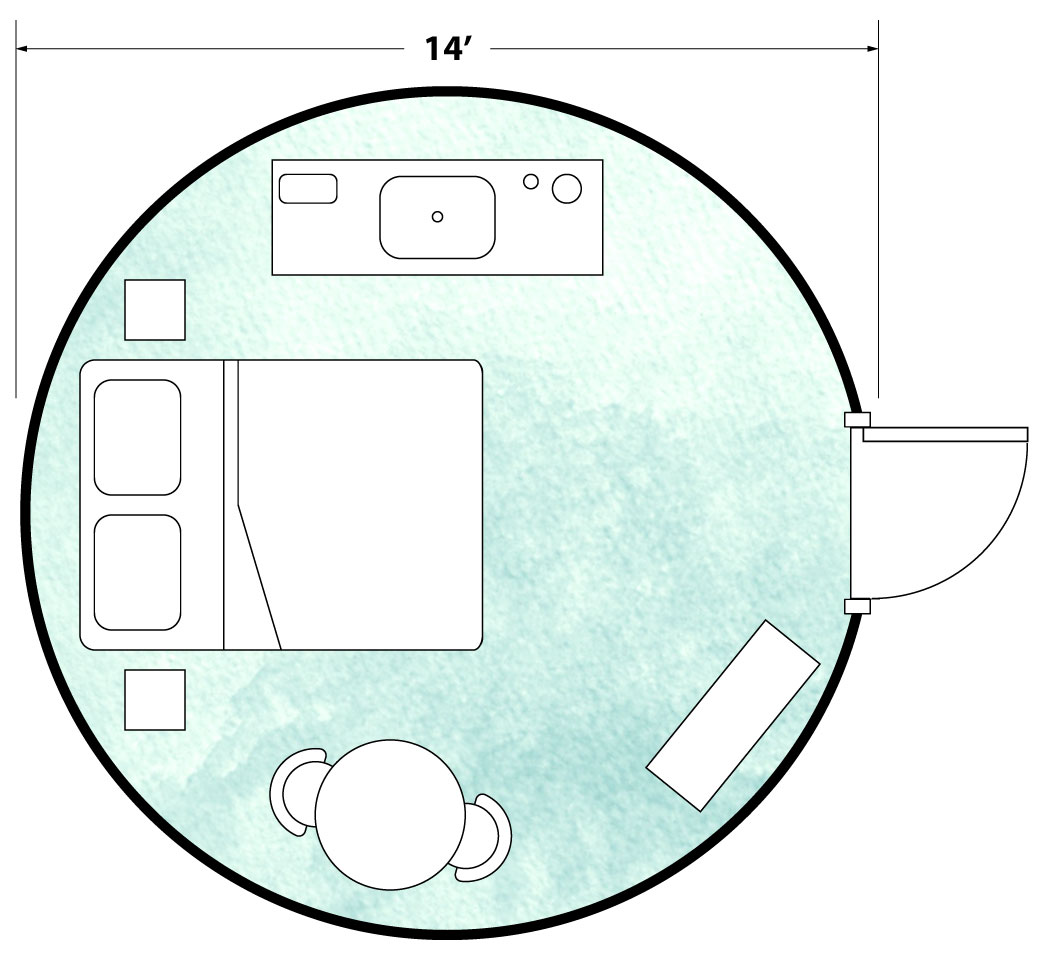
14-Foot Yurt Layout
A slightly larger 14-foot yurt has room for a bed, a sink, small table, or chair for lounging. The 14-foot sized yurt is a better option for couples who would like a little more room in their yurt.
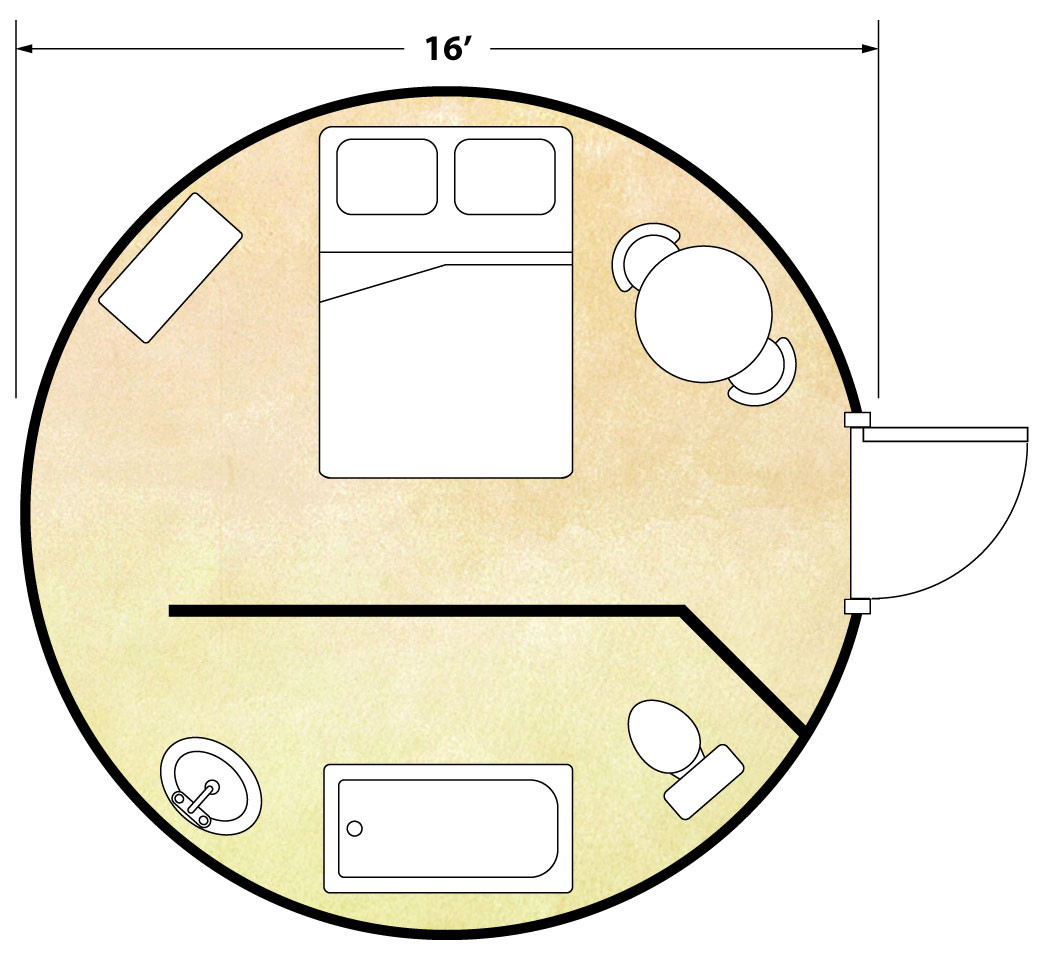
16-Foot Yurt Layout
A 16-foot yurt layout is roomy enough for a bathroom and a bedroom. With a partition wall, you could split up space into a studio-like living area. A 16-foot yurt is an ample option for a single person but room enough for a couple to use as a weekend getaway.
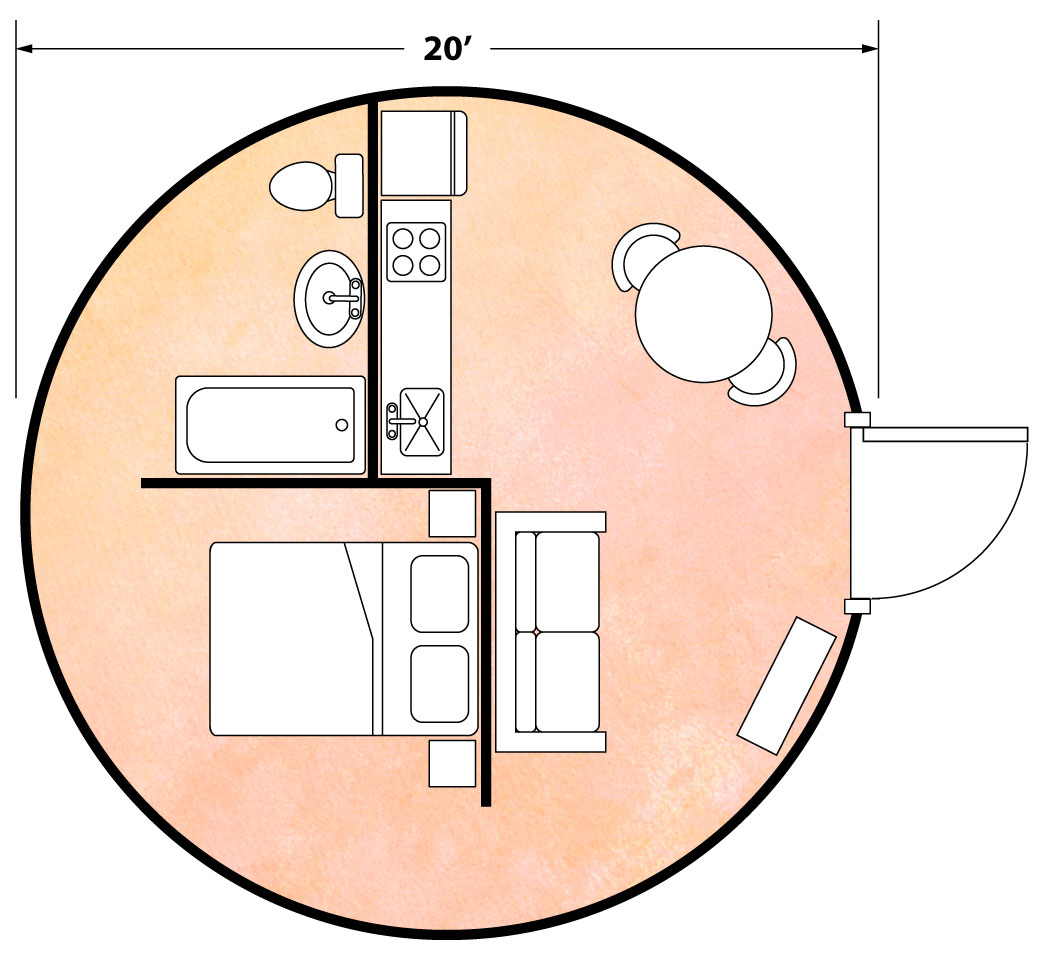
20-Foot Yurt Layout
A 20-foot yurt is roomy and comfortable enough for even a small family to make as a temporary home. As you can see from this layout, there’s room for a kitchen, a bathroom, and a small lounge area. With a futon or foldout couch, you could sleep up to four in this yurt.
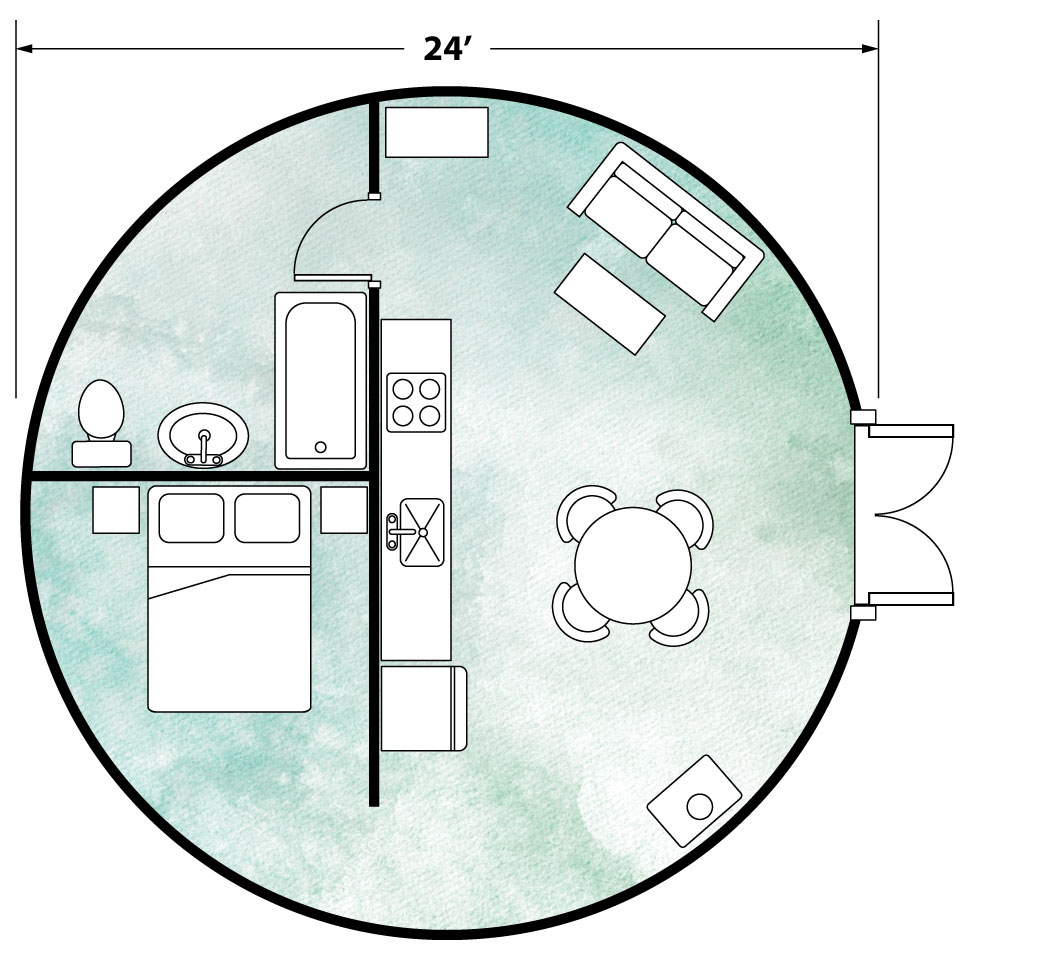
24-Foot Yurt Layout
A 24-foot yurt offers a really good amount of space for a family to use as a semi-permanent yurt home. Using inner walls to create partitions, you could divide the space into several rooms with some storage, lounge areas, and a spacious bathroom.
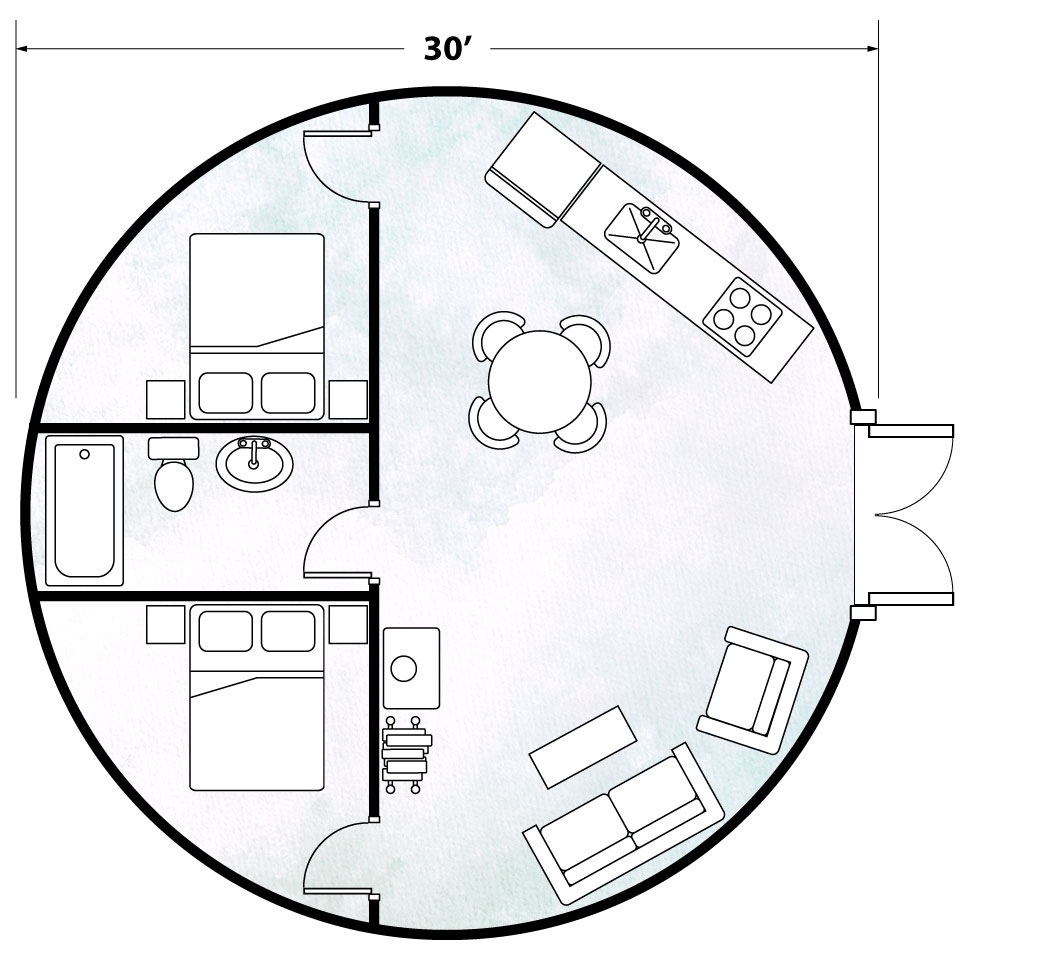
30-Foot Yurt Layout
A 30-foot or even a 50-foot yurt kit offers a significant amount of living space. You could easily have enough room for a small family for several months or a couple as a long-term or permanent yurt. If you build out the deck beyond the boundaries of the yurt walls, you could use the extra porch area for cooking and entertaining.
Designing A Great Yurt Interior

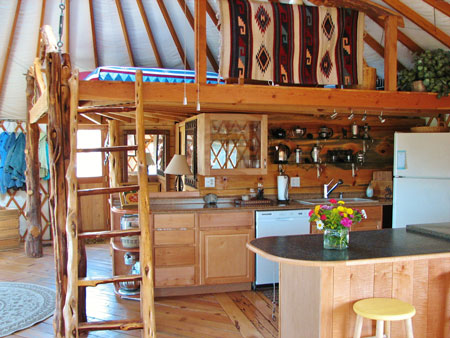 The interior needs of a yurt are pretty similar to those of a tiny house. If you have a bathroom or kitchen in your yurt, you will want to have access to hookups just like you would in your tiny home. The big difference is that with the fabric walls, your utilities will need to run on the interior.
The interior needs of a yurt are pretty similar to those of a tiny house. If you have a bathroom or kitchen in your yurt, you will want to have access to hookups just like you would in your tiny home. The big difference is that with the fabric walls, your utilities will need to run on the interior.
Many yurt owners put interior walls in the kitchen, bedroom, and bathroom to set up outlets and run utilities through there. As far as bathroom plumbing, composting toilets are a very popular option amongst yurt owners.
Besides being inexpensive, fun, and easy to build, the other big draw of a yurt is that it’s easy to build a yurt off-grid. For homesteaders and those looking for a temporary dwelling while they finish building their dream tiny home, a yurt is very appealing.
Here are a few examples of yurt interior design to inspire you.
Yurt Interior Partition Walls
The walls that break up the interior of your yurt are more like room dividers. Most leave some space between the top of the wall and the ceiling. You can use the interior walls for electric and as a spot to hang storage and even décor.
Wood Stoves for Yurts
Wood stoves are practical for off-grid living and many folks like them for yurts. Not only do they offer heat, but there are some beautiful choices too. You’ll need to consider how you plan to run the flue pipe through the canvas exterior. Some yurt kits come with a flue pipe option.
Yurt Kitchens
The most common choices for yurt kitchen design are L-shaped or galley kitchens. Typically, you’ll want to put your kitchen up against an interior partition wall since your utilities will be on the interior. Otherwise, a yurt kitchen is similar to other tiny house kitchens.
Yurt Windows
There are several options for yurt windows—you can have clear vinyl sewn into the outer fabric shell, you can use the screened windows that are part of the outer shell, or you can build in an actual window. Real windows are beautiful, efficient, and functional, but they’re more costly to install.
Yurt Home Kit Brands

Ready to try a yurt home for yourself? Here are the best yurt home kit brands to choose from. I highly recommend investing in a yurt kit to make building a yurt much simpler and faster. For the cost, it’s well worth it.
Best Brands for Yurt Home Kits


Pacific Yurts is one of the most popular yurt home kit brands in business since 1978.
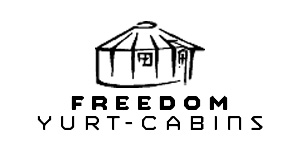
Freedom Yurt Cabins offer customizable yurt home kit choices with features like real windows.

The Colorado Yurt Company sells yurt home kits, tipis, and tents and offers many resources and guides.

Rainier Outdoor Company has been in business since the 1800s and offers an array of yurts and tipis.

Smiling Woods Yurts offers wood yurts and hexayurt kits to help you build a permanent yurt home.

Shelter Designs started building yurts back in 1999. There core designs include generous standard features in the base cost of every yurt kit.
If you’re ready to try yurt living, there are plenty of yurt home kit sellers to help you build a beautiful, spacious, and comfortable place to stay.
Your Turn!
- What size yurt most appeals to you?
- Would you feel comfortable living in a yurt?
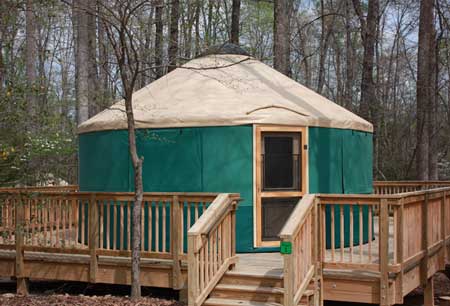




I’ve been flirting with the idea of living in a yurt for years. The main challenge has been convincing my wife of the charms of a yurt life. As a way of dealing with her timidity, I have thought about a two and a half structure with a main floor having the kitchen, bath, living room and library. The loft would be limited to an expansive bedroom/bath for the two of us. The ground floor would handle a two car garage and ancillary support areas. The diameter wold be in the 30-50 foot diameter range with the latter most probable.
I always thought about a location in the mountains of the West but the fires currently burning there give me pause to wonder. The coast and central regions of the U.S. rule them out due to tornadoes and hurricanes. That leaves me with the Appalachians. I spent years there while I was in the Army so I am familiar with the climate. My concern would be in finding a company with a track record of building in the region plus a locality that is yurt-friendly.
Do you know of someone you could recommend, with the knowledge, competence and men and equipment. who could build such a structure?
How much is a 30ft yurt
In the hexayurt category , I would recommend Deltec , out of Asheville NC . They offer prefab shells from tiny ( around 300 sq ft) to large ( over 2000 sq ft ) . Well built permanent structures from a company that’s been around for over 40 years . We have one of the larger ones that we use as the common house in our co housing community . It took about a week to put up the shell . Deltec provided a foreman , and we were his crew . We did the roofing and finished the interior ourselves . We did hire out the electrical , plumbing , and pouring the slab .
You left out the Great Lakes Yurt Company in Michigan, USA.